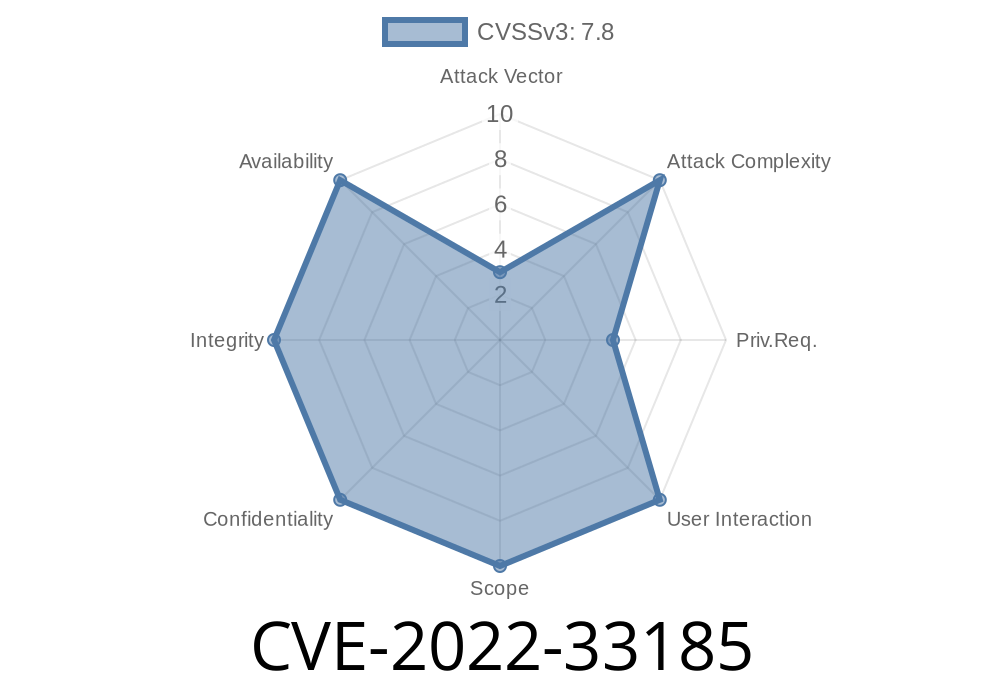A series of critical vulnerabilities have been identified in Brocade Fabric OS, specifically in versions earlier than v9..1e and v9.1.. CVE-2022-33185 refers to these vulnerabilities and it has been found that several commands in the affected versions of the operating system use unsafe string functions to process user input. Authenticated local attackers can exploit these vulnerabilities to cause stack-based buffer overflows, which could allow them to execute arbitrary code with the highest privileges (i.e., as the root user). In this post, we will break down the details of these vulnerabilities, provide examples of code snippets, and highlight the relevant original references.
Vulnerability Details
The vulnerabilities behind CVE-2022-33185 stem from the use of unsafe string manipulation functions in the affected versions of Brocade Fabric OS. More specifically, several commands in the operating system implementation use unsafe string functions like strcpy(), strcat(), and sprintf() to process user input without the proper length verification. As a result, an attacker with access to the system can potentially provide overly long input strings to these commands, triggering a stack-based buffer overflow.
Exploiting the vulnerability
To exploit these vulnerabilities, an attacker needs to have authenticated access to the targeted system, which can be achieved, for example, through password brute-force attacks or other means of credential theft. Once the access is obtained, the attacker can target the affected commands with carefully crafted input strings.
Here is an example of a code snippet that demonstrates how a vulnerable command can be exploited, assuming that the attacker already has the necessary access:
#include <stdio.h>
#include <stdlib.h>
#include <string.h>
#define BUFFER_SIZE 256
#define TARGET_COMMAND "/path/to/vulnerable/command"
int main(int argc, char *argv[]) {
char buffer[BUFFER_SIZE];
// Prepare the input string
memset(buffer, 'A', BUFFER_SIZE);
buffer[BUFFER_SIZE - 1] = '\';
// Execute the vulnerable command with the malicious input string
char command[512];
snprintf(command, sizeof(command), "%s '%s'", TARGET_COMMAND, buffer);
system(command);
return ;
}
The code above simply constructs a long input string and then invokes the targeted vulnerable command with that input. An attacker would typically craft the input string in such a way to control the values of specific memory locations, such as the return address of a function, and thus execute arbitrary code.
Original References
The CVE-2022-33185 vulnerability was initially reported by the Brocade Communications Systems Security team. The vulnerabilities have been addressed in the following software releases:
- Brocade Fabric OS v9..1e: Release Notes
- Brocade Fabric OS v9.1.: Release Notes
The official advisory from Brocade Communications Systems detailing these vulnerabilities can be found at the following link: Security Advisory
Mitigation
To remediate these vulnerabilities, affected system administrators should immediately upgrade their Brocade Fabric OS to the versions mentioned above (v9..1e and v9.1.).
Conclusion
CVE-2022-33185 highlights the importance of secure coding practices, specifically regarding the proper handling of user input data. System administrators should take immediate action to mitigate the risks associated with these vulnerabilities and ensure that their systems are up-to-date with the latest security patches. By staying vigilant and following security best practices, organizations can better protect themselves from potential attacks exploiting these types of vulnerabilities.
Timeline
Published on: 10/25/2022 21:15:00 UTC
Last modified on: 02/28/2023 18:01:00 UTC
